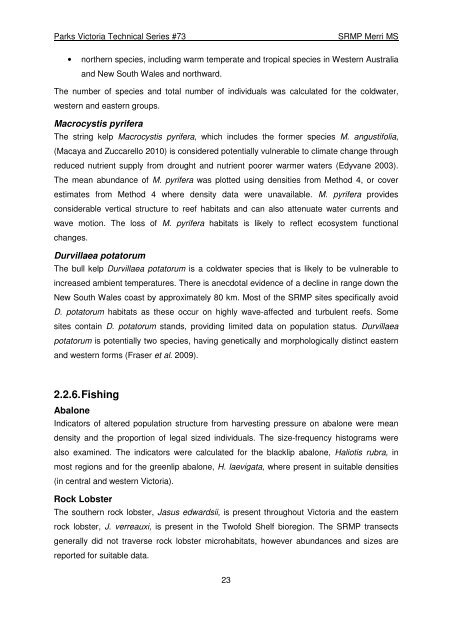Victorian Subtidal Reef Monitoring Program - Parks Victoria
Victorian Subtidal Reef Monitoring Program - Parks Victoria
Victorian Subtidal Reef Monitoring Program - Parks Victoria
Create successful ePaper yourself
Turn your PDF publications into a flip-book with our unique Google optimized e-Paper software.
<strong>Parks</strong> <strong>Victoria</strong> Technical Series #73<br />
SRMP Merri MS<br />
• northern species, including warm temperate and tropical species in Western Australia<br />
and New South Wales and northward.<br />
The number of species and total number of individuals was calculated for the coldwater,<br />
western and eastern groups.<br />
Macrocystis pyrifera<br />
The string kelp Macrocystis pyrifera, which includes the former species M. angustifolia,<br />
(Macaya and Zuccarello 2010) is considered potentially vulnerable to climate change through<br />
reduced nutrient supply from drought and nutrient poorer warmer waters (Edyvane 2003).<br />
The mean abundance of M. pyrifera was plotted using densities from Method 4, or cover<br />
estimates from Method 4 where density data were unavailable. M. pyrifera provides<br />
considerable vertical structure to reef habitats and can also attenuate water currents and<br />
wave motion. The loss of M. pyrifera habitats is likely to reflect ecosystem functional<br />
changes.<br />
Durvillaea potatorum<br />
The bull kelp Durvillaea potatorum is a coldwater species that is likely to be vulnerable to<br />
increased ambient temperatures. There is anecdotal evidence of a decline in range down the<br />
New South Wales coast by approximately 80 km. Most of the SRMP sites specifically avoid<br />
D. potatorum habitats as these occur on highly wave-affected and turbulent reefs. Some<br />
sites contain D. potatorum stands, providing limited data on population status. Durvillaea<br />
potatorum is potentially two species, having genetically and morphologically distinct eastern<br />
and western forms (Fraser et al. 2009).<br />
2.2.6. Fishing<br />
Abalone<br />
Indicators of altered population structure from harvesting pressure on abalone were mean<br />
density and the proportion of legal sized individuals. The size-frequency histograms were<br />
also examined. The indicators were calculated for the blacklip abalone, Haliotis rubra, in<br />
most regions and for the greenlip abalone, H. laevigata, where present in suitable densities<br />
(in central and western <strong>Victoria</strong>).<br />
Rock Lobster<br />
The southern rock lobster, Jasus edwardsii, is present throughout <strong>Victoria</strong> and the eastern<br />
rock lobster, J. verreauxi, is present in the Twofold Shelf bioregion. The SRMP transects<br />
generally did not traverse rock lobster microhabitats, however abundances and sizes are<br />
reported for suitable data.<br />
23

















